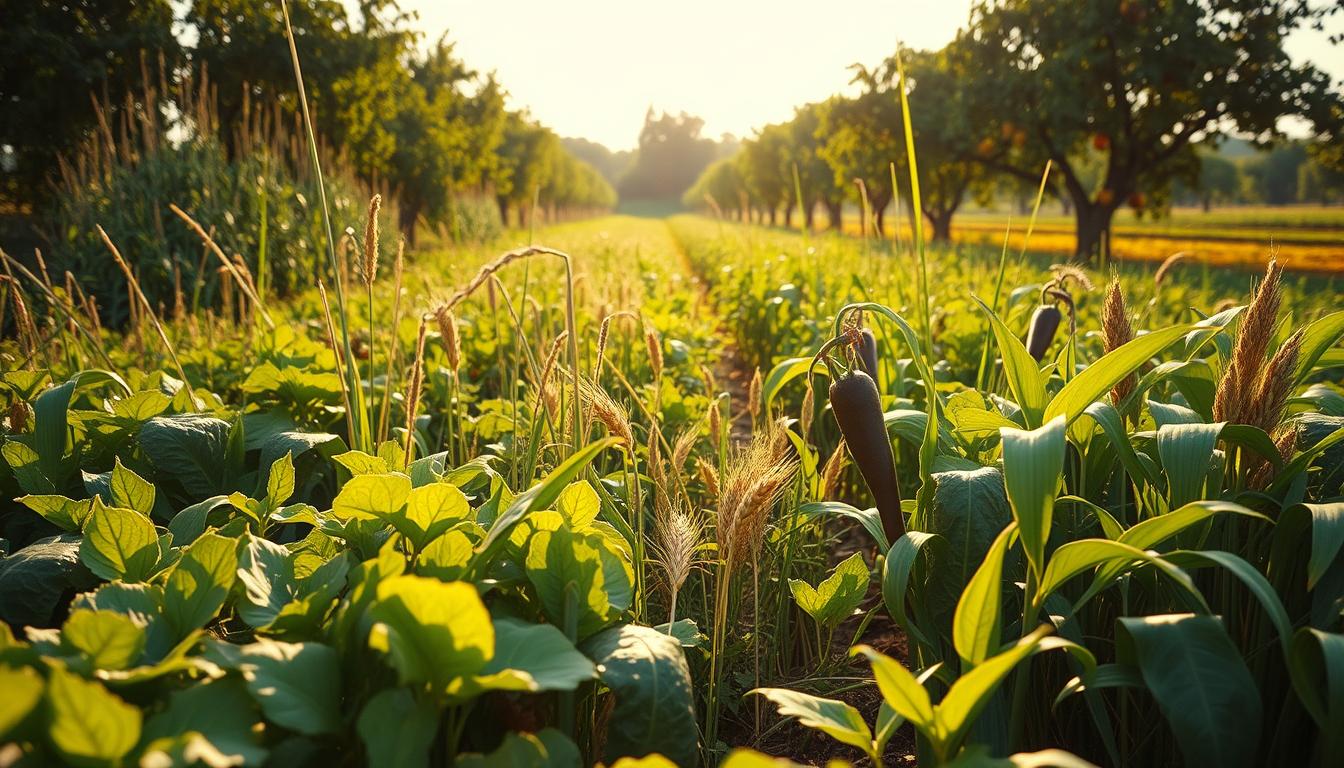Growing multiple crops together in the same field might seem old-fashioned. But modern farmers are finding it’s a smart move. By mixing crops, you can boost your farm’s output, improve soil health, and fight pests naturally.
These methods work for small family farms or large operations. They offer practical solutions to today’s farming problems.
Thoughtful crop pairing does more than just increase yields. It makes your farm more resilient to weather and less reliant on chemicals. Growers often use 30% less fertilizer with these methods.
In this guide, we’ll look at effective intercropping strategies for the U.S. You’ll learn how plants can help each other grow. We’ll cover planning crop combinations and transitioning to diverse farming.
These strategies are good for your farm’s health and the environment. They’re key to a sustainable future for American farming.
The Power of Plant Diversity in Modern Farming
Plant diversity in farming is key to sustainable agriculture. As climate issues grow, farmers are turning to nature’s wisdom. They’re moving from single crops to diverse plantings, blending old wisdom with new science.
Modern farming can learn a lot from nature’s ecosystems. By using intercropping, farms become stronger and less reliant on chemicals. This approach helps farms face environmental challenges head-on.
Monoculture farming is different from diverse planting. Experts now push for polyculture systems. This is because monoculture often fails, while diversity offers strong solutions.
Why Monoculture Falls Short
Monoculture farming is good for machines but weakens our food system. Growing one crop everywhere makes it easy for pests and diseases to spread. This leads to more pesticides and a costly cycle.
Monocultures also deplete soil nutrients, needing synthetic fertilizers to fix. Single crops don’t improve soil structure well. Without diverse roots, water doesn’t soak in, and erosion increases.
Extreme weather, becoming more common, shows monoculture’s weakness. These systems can’t handle stress well.
| Farming Aspect | Monoculture Approach | Diverse Planting Systems | Ecological Impact |
|---|---|---|---|
| Pest Management | Heavy reliance on pesticides | Natural pest suppression | Reduced chemical runoff |
| Soil Health | Nutrient depletion | Enhanced nutrient cycling | Improved carbon sequestration |
| Water Usage | Less efficient uptake | Complementary water needs | Better drought resilience |
| Biodiversity | Minimal habitat support | Creates diverse habitats | Supports pollinators and wildlife |
The Ecological Benefits of Diversity
Diverse planting systems work like natural ecosystems. Studies show they can boost productivity by 20-60% over monocultures. This is because different plants use soil resources in unique ways.
Deep-rooted plants and nitrogen-fixing legumes help each other. This natural process reduces the need for synthetic fertilizers. It also builds soil organic matter.
Plant diversity supports beneficial insects and microorganisms. These allies help control pests, saving billions annually. As climate change brings new challenges, diverse plantings spread risk across crops.
Intercropping builds ecological resilience. It’s like biological insurance against market and environmental risks. By working with nature, farmers can create sustainable systems for future generations.
Effective Intercropping Strategies for Sustainable Agriculture
Intercropping is a key part of sustainable farming. It means growing different crops together in the same field. This method is a big change from growing just one crop at a time.
Farmers who use intercropping see better soil health and fewer pests. They also get more food from each acre.
Definition and Core Principles
Intercropping means growing two or more crops together in the same field. It’s based on three main ideas: using resources together, helping each other grow, and not competing too much.
Using resources together means different crops get what they need at different times. Helping each other grow means one crop helps another, like when legumes make nitrogen for other plants. Not competing too much means arranging crops in a way that works best for everyone.
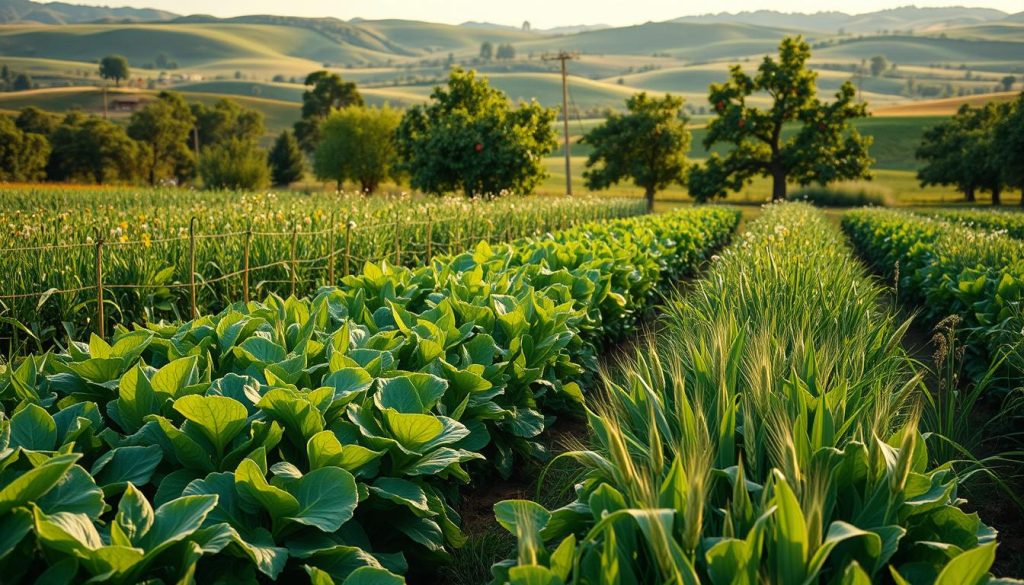
Historical Context and Traditional Practices
Intercropping isn’t new. Farmers all over the world have done it for thousands of years. The Native American “Three Sisters” system is a famous example.
In this system, corn, beans, and squash grow together. Corn gives beans a place to climb, beans make nitrogen, and squash keeps weeds down and soil moist. Similar ideas are found in farming traditions in Africa, Asia, and Latin America.
Modern Applications in Commercial Farming
Today, farmers are using intercropping again, but in new ways. They use strip intercropping, where crops are planted in wide bands. Relay intercropping lets them plant a second crop before harvesting the first.
Commercial farmers are also mixing intercropping with crop rotation. This creates complex but productive farms. It helps fight pests, improves soil, and makes farms more resilient to weather changes.
| Intercropping Type | Description | Benefits | Challenges |
|---|---|---|---|
| Mixed Intercropping | Multiple crops grown with no distinct row arrangement | Maximizes biodiversity, natural pest control | Difficult to mechanize, harvest complexity |
| Row Intercropping | Crops planted in alternating rows | Easier mechanization, good light penetration | Requires careful crop selection, timing |
| Strip Intercropping | Multiple rows of one crop alternated with another | Compatible with modern equipment, erosion control | Potential edge competition, complex planning |
| Relay Intercropping | Second crop planted before first is harvested | Extended growing season, improved land use | Precise timing required, potential yield trade-offs |
Companion Planting: Creating Synergistic Plant Relationships
Companion planting is more than just growing different crops together. It’s about creating special relationships between plants to make farming better. By using natural plant friendships, farmers can grow more food, keep pests away, and improve soil health. This method is based on centuries of knowledge and recent science.
Farmers who use companion planting often see fewer pests without using harmful chemicals. They also enjoy tastier food and make better use of their space. This makes companion planting great for both small gardens and big farms looking for green ways to farm.
Classic Plant Combinations That Work
Some plant pairs have been favorites for ages, working well in many places. These classic teams show how companion planting works in real life. Long before science caught up, farmers noticed these helpful pairings.
Vegetables and Herbs Pairings
Herbs can really help vegetables in the garden. For example, tomatoes and basil are a great team. Basil keeps tomato hornworms away and makes tomatoes taste better. Carrots and onions also work well together because onions hide the smell that attracts carrot flies.
Marigolds are another great choice for gardens. Their roots fight nematodes and other pests in the soil. They also add color and protect many crops at once.
| Primary Crop | Companion Plant | Benefit | Spacing Consideration |
|---|---|---|---|
| Tomatoes | Basil | Repels flies and mosquitoes, improves growth and flavor | Plant basil 10-12 inches from tomatoes |
| Cabbage family | Aromatic herbs (thyme, mint) | Confuses cabbage moths and other pests | Intersperse throughout cabbage rows |
| Carrots | Onions/Leeks | Onion family deters carrot fly | Alternate rows or plant in close proximity |
| Most vegetables | Marigolds | Controls nematodes, attracts pollinators | Border plantings or scattered throughout |
Field Crop Companions
Big farms can also use companion planting to their advantage. The “Three Sisters” method of planting corn, beans, and squash is a classic example. Corn gives beans a place to climb, beans fix nitrogen for corn and squash, and squash keeps the soil cool and weeds down.
Today, farmers plant wheat with clover to get more nitrogen and prevent soil erosion. Sunflowers alongside cucurbits like squash and melons offer wind protection and attract pollinators for both crops.
The Science Behind Plant Compatibility
Companion planting isn’t just old wives’ tales; it’s backed by science. Allelopathy, or how plants interact through chemicals, explains many of these relationships. Some plants help their neighbors grow or keep weeds away.
Physical protection is another reason plants pair up. Tall or thorny plants can protect smaller ones from wind or animals. Mixing different plants also helps fight pests and creates better growing conditions.
Studies from places like Cornell and UC Davis show how companion planting helps beneficial insects. The right plants attract insects that eat pests. For example, dill and fennel attract wasps that fight caterpillars and aphids on nearby crops.
Mixed Cropping Systems for Increased Yield and Resilience
Mixed cropping systems are great for using land well and making farms stronger. They are different from single crops that can be hit hard by pests and market changes. In mixed cropping, many crops grow together, like in nature.
This method helps farmers grow more food and face less risk. It can make a field produce 20-60% more than growing just one crop. It also helps protect against crop loss due to weather or pests.
Designing Effective Mixed Crop Layouts
Creating good mixed cropping systems needs careful planning. It’s important to think about how plants grow and interact. This includes their height, root system, growth speed, and what nutrients they need.
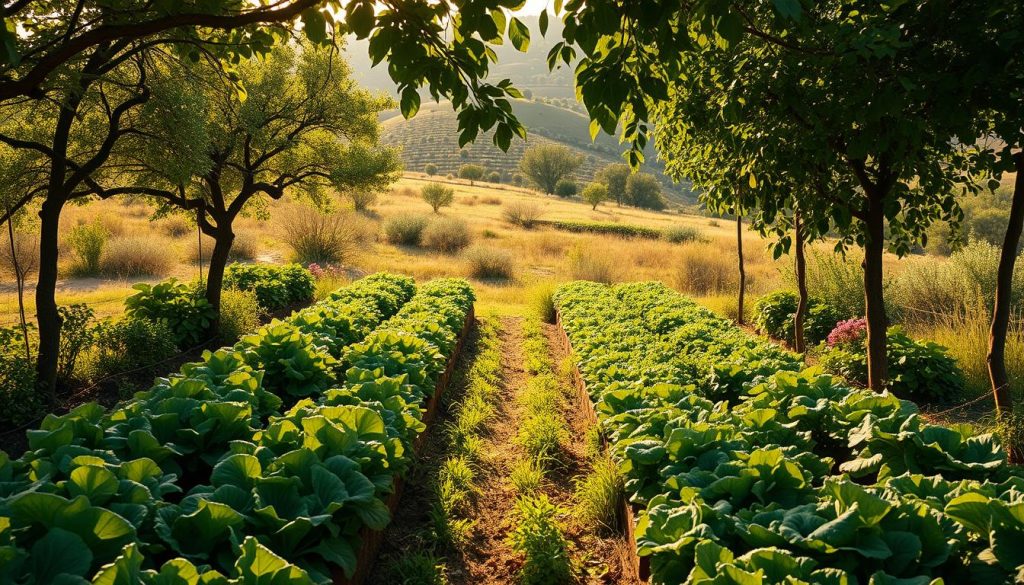
Using space well is key. Planting tall crops like corn with beans and squash makes the most of sunlight. This way, farmers can grow more food in the same area.
It’s also important to think about roots. Mixing deep-rooted crops with shallow-rooted ones helps them get nutrients from different levels of the soil. For example, carrots and lettuce work well together because they use different parts of the soil.
When planning, timing is crucial. Quick-growing crops can be picked before slower ones need more resources. This way, there’s less competition and more time to grow food.
| Design Factor | Consideration | Example Combination | Benefit |
|---|---|---|---|
| Vertical Structure | Plant height differences | Corn + Beans + Squash | Maximizes sunlight capture |
| Root Architecture | Different rooting depths | Carrots + Lettuce | Accesses nutrients at multiple soil levels |
| Growth Timeline | Varying maturation rates | Radishes + Cabbage | Extends harvest period, reduces competition |
| Nutrient Needs | Complementary requirements | Legumes + Grains | Natural nitrogen cycling between crops |
Case Studies: Successful Mixed Cropping Farms
Farms across America are proving the benefits of mixed cropping every day. From small gardens to big farms, they’re using mixed cropping to grow more and face less risk.
Small-Scale Success Stories
In Vermont, Growing Heart Farm has a mixed cropping system that helps them grow more and improve soil health. They plant over 30 types of vegetables in blocks, increasing their income by 40% compared to single crops. They mix quick-growing greens with longer-season crops.
Tahoma Farms in Washington state also uses mixed beds. They plant crops that grow well together and are picked at different times. This method makes them produce almost twice as much as single-crop farms, using less water and fertilizer.
Commercial-Scale Implementation
Bigger farms face challenges with mixed cropping, like using equipment for many crops. But, farmers in Iowa have found ways to adapt. They’ve made special equipment to manage cereal grains and legumes on hundreds of acres together.
In California, Full Belly Farm shows how mixed cropping can work on a large scale for vegetables. Their 400-acre farm uses intercropping to increase yields by 30% and cut pesticide use by over 50%. They’ve modified their equipment to harvest mixed crops efficiently.
These stories show that mixed cropping works differently for everyone. It’s about adapting ecological ideas to your farm, soil, and market. The most successful farms keep learning and improving their methods.
Relay Cropping: Maximizing Growing Seasons and Land Use
Relay cropping is a smart way for farmers to grow more food on the same land. It involves planting a second crop into the first one before it’s harvested. This method uses land and growing seasons more efficiently, helping farmers grow more while keeping the soil healthy.
In areas with short growing seasons, relay cropping is a game-changer. It lets farmers grow two crops in one year, extending their harvest time. This not only boosts total yield but also spreads out the harvest work, avoiding bottlenecks and gluts.
Relay cropping also helps the environment. It keeps the soil covered, reducing erosion and weeds. Different crops’ roots reach different soil layers, improving soil health and using nutrients better.
Timing Your Plantings for Continuous Harvest
Getting the timing right is key for relay cropping. The second crop must be planted when the first is mature but not too close to harvest. This timing varies based on the crops and local weather.
In the northern U.S., farmers often frost-seed red clover into winter wheat in spring. As wheat grows, clover starts to grow under it. After wheat is harvested in summer, clover grows fast, offering forage or green manure before winter.
Another good pair is soybeans planted into standing winter wheat when wheat is 12 inches tall. Soybeans grow slowly until wheat is harvested, then grow fast in summer. This can increase land productivity by 20-40%.
Crop Selection for Successful Relay Systems
Not all crops are good partners for relay cropping. The best ones have different growth habits and maturity dates. The first crop should let the second one get enough light, while the second crop can handle some shade early on.
Height differences are also important. Tall crops like corn can be paired with short legumes like cowpeas or beans. Cool-season grains and warm-season broadleaves also work well together.
In the Upper Midwest, farmers plant winter rye followed by pumpkins or squash. Rye suppresses weeds early, and is harvested or rolled down when warm-season crops need more space. In the Great Plains, millet is relayed into early-season peas, doubling the productive period and keeping soil covered all year.
When picking crops for relay systems, think about their biological fit and practical harvesting. Crops with different harvest methods or equipment needs often work well together, making harvesting easier.
Strip Cropping: Combining Erosion Control with Productivity
Strip cropping is a smart way to fight erosion and keep farms productive. It involves planting different crops in strips across fields. These strips run up and down slopes or with the wind.
This method works because it uses crops that stop erosion in between others that grow well. For example, hay or small grains stop erosion, while corn or soybeans grow well. This way, water doesn’t wash away soil as much.
Farmers in the Midwest have seen a big drop in soil loss. They’ve lost up to 75% less soil, yet their crops still grow well. This shows that strip cropping is good for both the land and the farmer’s pocketbook.
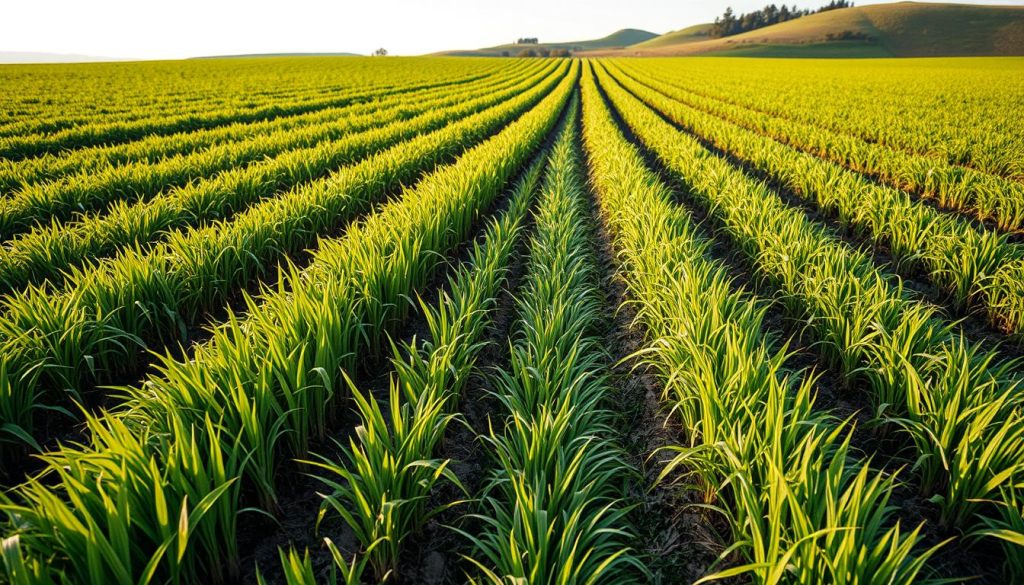
Designing Effective Strip Patterns for Different Landscapes
Creating good strip patterns needs careful thought about your land. The width of the strips is key. It depends on the slope and soil type.
On gentle slopes, wider strips work well. But on steeper slopes, narrower strips are better. Soil type also affects the strip width.
There are three main types of strip cropping:
Contour strip cropping fits the land’s curves, great for Iowa and Missouri. Field strip cropping uses straight strips for flat fields in the Midwest. Buffer strip cropping protects waterways and sensitive areas with permanent plants.
In Washington and Idaho, farmers have made strip cropping work on very steep land. They’ve seen great results.
Equipment Considerations and Adaptations
Starting strip cropping means thinking about your equipment. Most farm gear is made for big, flat fields. But, you can adjust it for strip cropping.
How wide your equipment is matters a lot. It should fit evenly with your strip width. For example, a 30-foot planter works with strips of 60, 90, or 120 feet.
GPS systems help a lot with strip cropping. They guide the farmer along the land’s curves. This makes the job easier and more accurate.
Some farmers add special features to their equipment. Others buy gear that can handle different crops easily.
| Strip Cropping Type | Best Landscape Application | Erosion Reduction Potential | Equipment Challenges | Ideal Strip Width |
|---|---|---|---|---|
| Contour Strip Cropping | Rolling hills, moderate slopes | 60-80% | Curved paths require precision steering | 75-120 feet |
| Field Strip Cropping | Gentle slopes, wind-prone areas | 40-60% | Minimal; straight paths are equipment-friendly | 100-200 feet |
| Buffer Strip Cropping | Near waterways, environmentally sensitive areas | 70-90% | Requires equipment for multiple crop types | 30-100 feet |
| Grassed Waterway Integration | Natural drainage pathways | 80-95% | Working around permanent vegetation | Variable based on water flow |
Strip cropping is a win-win for farmers and the environment. By planning your strips and adjusting your equipment, you can cut down on soil loss. This keeps your farm productive and sustainable for the long haul.
Alley Cropping and Agroforestry: Long-term Intercropping Solutions
Farmers are exploring new ways to manage land for decades, not just seasons. Alley cropping and agroforestry are key strategies. They mix trees with crops, creating a natural farming environment. This approach adds value over years, changing the land and farm’s finances.
Alley cropping uses trees or shrubs with crop alleys. It’s easy to maintain with common farm tools. Agroforestry goes further, combining plants in complex ways. It’s a top choice for sustainable farming today.
Integrating Trees with Annual Crops
Tree and crop integration needs careful planning. Trees are spaced 40-60 feet apart for crop growth. Trees are planted north-south to get more sunlight for crops and offer wind protection.
Good pairings include walnut trees with corn or soybeans. Apple trees work well with vegetables. Trees like oak or poplar help forage crops. The goal is to choose trees that help, not harm, crops.
Deep-rooted trees get nutrients and water that annuals can’t. Trees like locust fix nitrogen, enriching soil for crops.
Economic Benefits of Multi-story Farming
Agroforestry offers income at different times. Crops give quick cash, while trees grow. As trees mature, fruits, nuts, and herbs add more income.
This system is more productive than single crops. Trees and crops use resources at different levels. This multi-layered farming boosts total output per acre.
Agroforestry also offers ecosystem services. These include carbon sequestration, better water, and wildlife habitats. These services can earn money, making the farm more profitable over time.
Planning for Decades: The Long View of Agroforestry
Agroforestry planning spans decades, not seasons. Farmers must think about how the system will change as trees grow. Early stages focus on sun-loving crops, later on shade-tolerant ones.
Success requires flexible plans that adjust to changes. In the Midwest, oak savannas and in the Southeast, pine and grazing mix well. In the Pacific Northwest, food forests show agroforestry’s potential in temperate climates.
Agroforestry is a long-term commitment to the land. It builds soil, sequesters carbon, and ensures ecological health for future generations. With careful planning, it offers a sustainable future for farm families.
Polyculture: Creating Resilient Agricultural Ecosystems
Polyculture is at the forefront of sustainable farming. It’s a way to grow many crops together, making farms strong against environmental changes. Unlike simple farming, polyculture mirrors nature’s diversity, making farms more stable and productive with less outside help.
Polyculture mixes plants in a way that helps each other. This can include plants above and below ground, using space well. It helps farms use sunlight better, manage water, and improve soil health naturally.
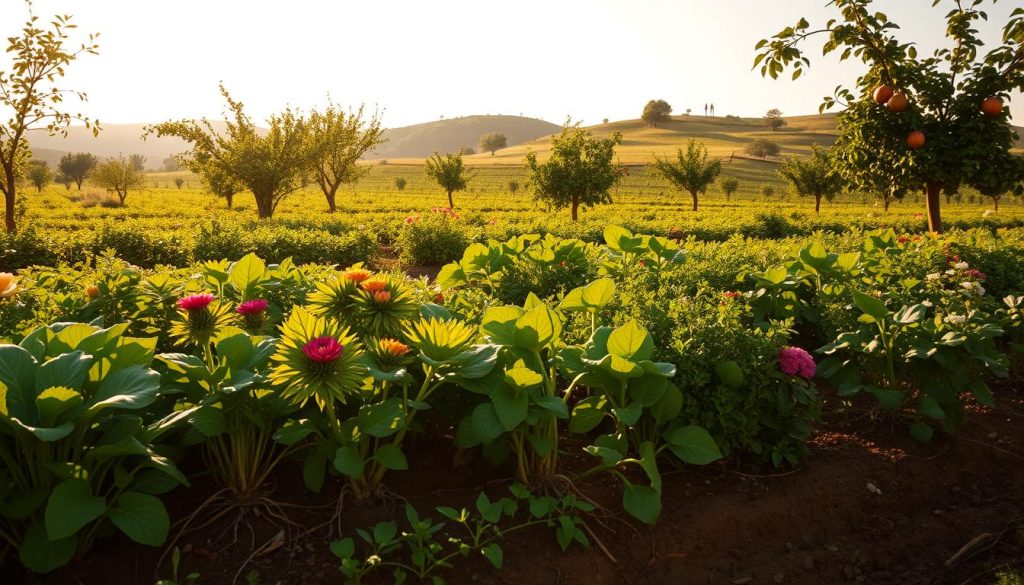
Beyond Simple Combinations: Complex Polycultures
Advanced polyculture systems use five or more plants, each with its own role. This can include plants that fix nitrogen, plants that help with soil health, and plants that attract good bugs. This complexity strengthens the whole system.
In the U.S., many are trying out different polyculture models. Food forests mix fruit trees with berries and herbs, like a woodland. Grain mixes with legumes and oilseeds help the soil and fight disease. Market gardens pack a lot into small spaces, cutting down on pests.
Biodiversity as Crop Insurance Against Climate Change
Biodiversity is like nature’s insurance against extreme weather. Different plants react differently to drought, rain, and pests. If one plant struggles, others can keep the farm productive.
Studies show polycultures are more stable than single crops, even in tough weather. The Land Institute found prairie polycultures were 73% less variable in drought years. This stability is key as the weather gets wilder.
Farmers using polyculture also see benefits like better water use and soil health. These natural defenses help farms stay productive, even in harsh weather, with less need for expensive fixes.
Conservation Agriculture Through Crop Rotation and Intercropping
Combining conservation agriculture with intercropping boosts soil health and keeps farms productive. This method helps farmers work with nature, not against it. It leads to sustainable farming that’s good for the environment and the economy.
Conservation agriculture is a big change from old farming ways. It focuses on making soil healthy for crops. Adding intercropping to this approach helps farmers make their farms more resilient.
Principles of Conservation Agriculture
Conservation agriculture has three main parts for sustainable farming:
- Minimal soil disturbance – Less tillage keeps soil structure and helps soil life. Intercropping keeps roots in the soil all the time.
- Permanent soil cover – Plants or residue on the soil stop erosion and keep it cooler. Intercropping covers more ground with different plants.
- Crop diversity – Rotating crops breaks pest cycles and improves soil. Intercropping adds more diversity by growing many crops together.
Using these principles together builds soil organic matter. This makes soil better at holding water and needing less outside help. Soil becomes stronger against weather and needs fewer chemicals.
Integrating Cover Crops in Intercropping Systems
Cover crops are key in intercropping, offering many benefits. They can be added in several ways:
- Relay planting – Planting cover crops before the main crop is harvested lets them grow while the main crop finishes.
- Undersowing – Planting cover crops under taller crops makes a living mulch that fights weeds and protects soil.
- Strategic termination – Ending cover crop growth at the right time releases nutrients for the next crop.
In the Midwest, farmers mix cereal rye with soybeans and corn. In the Southeast, they use crimson clover and winter peas with vegetables. In the West, they plant drought-tolerant cover crops to improve water use.
These methods cut down on herbicide and fertilizer costs. They also help the environment. It might take new skills, but many farmers find it easier as soil health improves.
Natural Pest Management Benefits of Diverse Planting
Intercropping strategies offer more than just higher yields. They also provide top-notch pest management, changing a farm’s ecological balance. By mixing different plant species, farmers create natural barriers against pests. This method stops pests from spreading, confuses them with different smells and shapes, and boosts beneficial insects that fight pests.
Studies from the U.S. show intercropping can keep pests under control without chemicals. Farmers using this method save money, grow better crops, and protect the environment.
Intercropping works on nature’s rules, not technology. It makes farms strong against pests and less reliant on chemicals. Let’s look at how it works.
Trap Crops and Deterrent Plants
Trap cropping is a key way to manage pests through companion planting. It involves growing plants that pests love next to your main crops. These “sacrificial” plants draw pests away from your valuable crops.
For example, farmers growing cabbage might plant collards around it. Collards attract pests like diamondback moths and cabbage loopers, making it easier to control them.
Deterrent plants repel pests with their smells or chemicals. Marigolds fight nematodes in soil, while herbs like basil and rosemary confuse pests by hiding their scent.
| Trap Crop | Target Pest | Main Crop Protected | Planting Pattern |
|---|---|---|---|
| Nasturtiums | Aphids | Tomatoes, Peppers | Border or scattered throughout |
| Blue Hubbard Squash | Cucumber beetles | Cucumbers, Melons | Perimeter planting |
| Mustard | Flea beetles | Brassicas (Broccoli, Kale) | Strips between rows |
| Radish | Root maggots | Onions, Carrots | Interplanted within rows |
Creating Habitat for Beneficial Insects
Good intercropping does more than just keep pests away. It also helps beneficial insects, making farms self-regulating. This way, farmers need less help from chemicals.
Beneficial insects eat pests or lay eggs inside them. They need shelter, food, and places to breed. Intercropping gives them these things.
This makes farms strong against pests and less dependent on chemicals. Let’s see how it works.
Flowering Plants for Pollinators
Adding flowering plants to your intercropping system helps in many ways. They give nectar and pollen to pollinators and beneficial insects. Many insects need flowers as adults, even if their babies eat pests.
Choose plants that bloom all season. Early bloomers like phacelia and alyssum are followed by mid-season ones like buckwheat and cosmos. Sunflowers and goldenrod bloom in fall.
Native plants are better for local insects than non-native ones. The Xerces Society found native plants attract more beneficial insects than ornamentals.
Predator-Friendly Farm Design
The way plants are arranged in intercropping systems matters a lot. It’s not just about mixing crops. Adding special features helps predators too.
Beetle banks are raised strips of grass that help ground beetles and spiders. These insects eat many pests. Beetle banks need little care once set up.
Insectary strips are rows of flowers that help beneficial insects. They let these insects move around. Make sure your main crops are no more than 100 feet from these strips.
Permanent hedgerows with native plants and perennials help insects and birds all year. They also protect against wind, stop erosion, and make the climate better for crops.
Overcoming Challenges in Implementing Intercropping
Intercropping systems bring new challenges for farmers. They need to change their equipment, crop management, and business models. Successful farmers make small changes that add up over time. Knowing the common problems and solutions helps make the transition smoother.
Equipment and Mechanization Considerations
Farm machinery is often made for monoculture farming. Farmers might start by tweaking their current equipment. They adjust planters for different seeds or add dividers for alternating rows.
Technology like GPS-guided equipment helps with intercropping. It ensures accurate planting and monitors crop needs. For smaller farms, specialized tools like multi-row seeders are cost-effective.
Managing Competition Between Crops
Good intercropping balances competition and benefits between plants. Spacing is key, with plants that complement each other closer together. Planting at the right times also helps avoid competition for resources.
Managing plant heights is crucial in mixed cropping. Taller plants should not shade shorter ones. Staggered planting dates help the first crop grow before adding companion plants.
Economic Transition Strategies
Switching to intercropping needs careful financial planning. Most farmers start small, testing new methods before scaling up. This approach helps manage risks and gain experience.
Financial Planning for System Change
Allow for yield changes in the first 2-3 years. A financial buffer is essential during this time. USDA programs and grants can help cover costs.
Diversifying crops can stabilize income. Even if individual yields drop, overall profitability can increase. Reduced input costs also help.
Marketing Diverse Farm Products
Intercropping opens doors to specialty markets. Direct sales through farmers’ markets and CSAs can fetch high prices. A strong farm story about sustainability can stand out in the market.
Creating value-added products can turn challenges into opportunities. Working with other farmers can also help distribute diverse crops efficiently.
The Future of Farming: Integrating Intercropping into Modern Agriculture
Intercropping strategies are becoming key for tomorrow’s farms as climate challenges grow. Farmers in America are finding these methods solve real problems like soil health and pest management.
New research is on the way to create plant varieties that work well together. Scientists aim to grow crops that complement each other, not compete. This approach helps farming systems work with nature, not against it.
Technology is making it easier to plant and manage complex systems. With GPS, drones, and special tools, intercropping is becoming more accessible at a large scale.
Policy changes are also supporting these practices. New crop insurance, carbon credits, and incentives make diverse farming financially appealing. These moves highlight the benefits of farming with nature.
More people want food grown sustainably, offering a chance for farmers to earn more. This demand helps farmers get better prices for their diverse crops.
The future of farming blends old wisdom with new science. Today’s farmers have tools and knowledge to make intercropping more effective than ever. This mix of tradition and innovation is crucial for success.
Intercropping strategies offer resilience in uncertain times. By adopting these methods, American farmers are shaping the future of agriculture.

